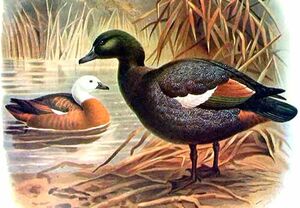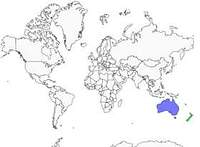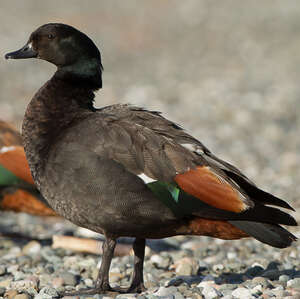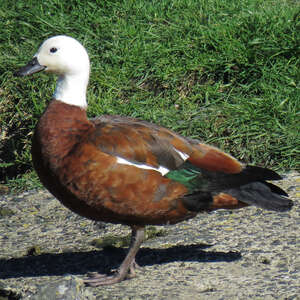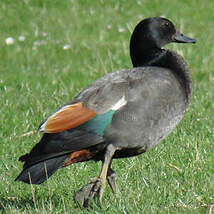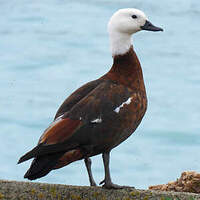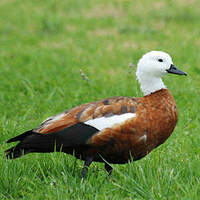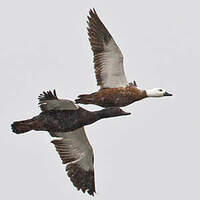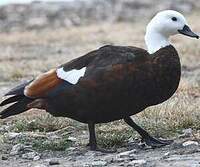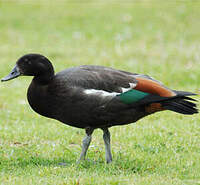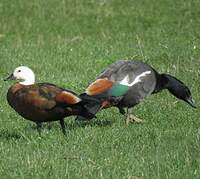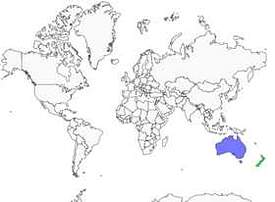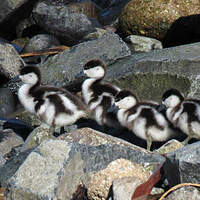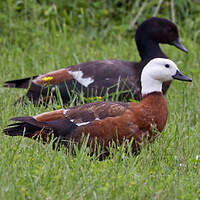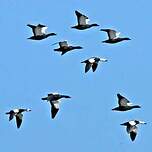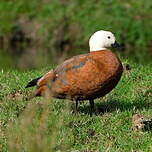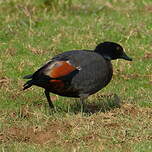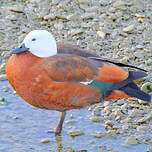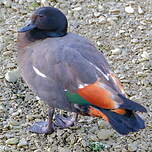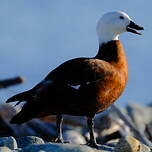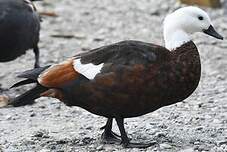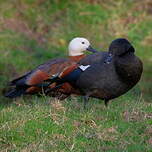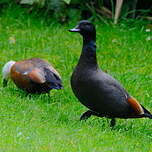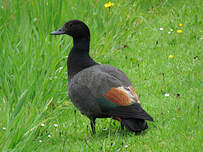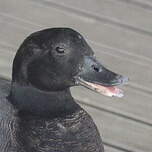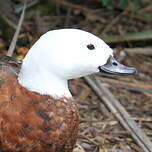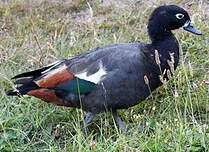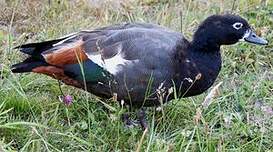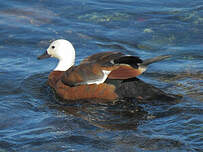Paradise Shelduck
Tadorna variegata - Tadorne de paradis
Identification
The Paradise Shelduck is a large duck with strong sexual dimorphism that cannot be confused with any other species on the ground. The adult male is a very dark bird; the head and neck are black with greenish reflections, the body is dark gray with thin black bars. Colored notes, tertials and under tails are orange. In flight, the underside of the wings is light (white coverings and gray primaries) while the top has a strong contrast between the coverings (white) and the primaries (black). The female is more colorful, white head (black beak), orange upper and lower body and wings identical to the male's. The juveniles look very much like the male, but females have a white line from the base of the beak and extending beyond the eye.
Subspecific information monotypic species
Foreign names
- Tadorne de paradis,
- Tarro maorí,
- tadorna-maori,
- Paradiesgans,
- új-zélandi ásólúd,
- Paradijscasarca,
- Casarca del paradiso,
- paradisgravand,
- Maorirustand,
- kazarka rajská,
- husice rajská,
- Paradisgravand,
- paratiisisorsa,
- ànec maori,
- kazarka rajska,
- Новозеландский огарь,
- クロアカツクシガモ,
- 黑胸麻鸭,
- 黑胸麻鴨,
Voice song and call
Habitat
Behaviour character trait
Dietfeeding habits
Reproduction nesting
The breeding season extends from August to January. Breeding pairs actively defend their territory (usually a portion of the shore of a water body or a stream).
Any intruder is chased away; the owner of the place first approaches by walking, head low, neck stretched; if that is not enough, the intruder is attacked and pursued in flight. The nest can be placed in all kinds of cavities, a tunnel under a tuft of vegetation is sometimes enough, but most often it is a cavity in a tree or cliff that is used.The laying is usually 8 to 10 eggs and the female incubates for about 5 weeks. The chicks fly at the age of about 2 months. A study showed that only 2 to 4 chicks make it to take off (a success rate of barely 45%).
Sometimes there are two clutches.
Geographic range
Threats - protection
IUCN conservation status
concern
in the Wild
threatened
evaluated
The population is estimated to be between 150,000 and 180,000 individuals, and is relatively stable. Main threats include introduced predators (polecats and ermines) and hunting. On the other hand, the Paradise Shelduck has benefited from the modifications colonists have made to the environment (deforestation, construction of multiple bodies of water).
Sources of information
- IOC World Bird List (v15.1), Gill, F and D Donsker (Eds). 2025-12-07.
- Guide des canards, des oies et des cygnes, Steve Madge
- The hand guide to the birds of New Zealand, Robertson Hugh et Heather Barrie
- Vol. 1 - Handbook of the Birds of the World, Josep del Hoyo-Andrew Elliot-Jordi Sargatal
- Waterbird Population Estimates, Simon Delany Derek Scott
- Avibase, Lepage Denis
- New Zealand birds and birding, Narena Olliver
Other sources of interest
 Specification sheet created on
30/07/2023 by Georges Olioso
Specification sheet created on
30/07/2023 by Georges OliosoTranslation by AI Oiseaux.net
© 1996-2025 Oiseaux.net
- Accipitriformes
- Aegotheliformes
- Anseriformes
- Apodiformes
- Apterygiformes
- Bucerotiformes
- Caprimulgiformes
- Cariamiformes
- Casuariiformes
- Charadriiformes
- Ciconiiformes
- Coliiformes
- Columbiformes
- Coraciiformes
- Cuculiformes
- Eurypygiformes
- Falconiformes
- Galliformes
- Gaviiformes
- Gruiformes
- Leptosomiformes
- Mesitornithiformes
- Musophagiformes
- Nyctibiiformes
- Opisthocomiformes
- Otidiformes
- Passeriformes
- Pelecaniformes
- Phaethontiformes
- Phoenicopteriformes
- Piciformes
- Podargiformes
- Podicipediformes
- Procellariiformes
- Psittaciformes
- Pterocliformes
- Rheiformes
- Sphenisciformes
- Steatornithiformes
- Strigiformes
- Struthioniformes
- Suliformes
- Tinamiformes
- Trogoniformes

